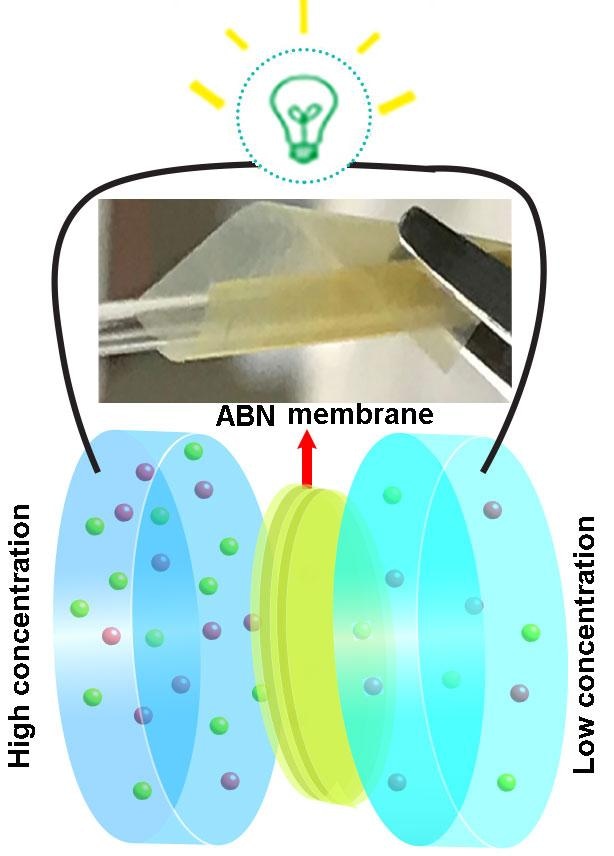Dec 19 2019
Taking a cue from membranes present in the body tissues of living organisms, researchers have constructed a novel membrane by integrating boron nitride with aramid nanofibers that are utilized in Kevlar.
 This diagram depicts bio-inspired nanocomposite membranes for efficient blue energy harvesting. Image Credit: Chen et al.
This diagram depicts bio-inspired nanocomposite membranes for efficient blue energy harvesting. Image Credit: Chen et al.
The aim of this study was to harvest ocean energy that is not only strong like bone but also suitable for transporting ions, quite similar to cartilage.
The study resolves significant design complications for technologies harnessing osmotic energy—differences of salinity and pressure gradient between ocean water and freshwater—to produce an abundantly available and eco-friendly form of renewable energy. The study has been published in the Joule journal on December 18th, 2019.
When compared to wind and solar energy farms, osmotic energy generators do not differ much from one day to the next. As a result, they are more dependable as opposed to these green energy staples.
However, the MXene, graphene oxide, clay, and molybdenum disulfide nanomaterials, which are often utilized in membranes, typically collapse and disintegrate in water.
Boron nitride-based nanosheets have exhibited immense potential lately; for example, they do not react easily with other substances and continue to be stable with increasing temperatures.
However, even boron nitride-based membranes are not sufficiently hard to tolerate water for a prolonged period of time and they quickly begin to leak ions as they develop tiny cracks.
New advanced boron nitride composite membranes with novel and robust properties will solve this problem, which is in high demand now.
Weiwei Lei, Project Lead Scientist and Senior Research Fellow, Institute for Frontier Materials, Deakin University
“Osmotic energy represents an enormous resource for humankind, but its implementation is severely limited by the availability of the high-performance ion-selective membranes,” stated Nicholas Kotov, a professor of engineering at the University of Michigan and the lead researcher in the United States.
Lei, Kotov, and their collaborators went on to solve this issue by using the body tissues of living creatures as a blueprint. They subsequently observed that high-performance ion-selective membranes of several different varieties are required to promote the biological reactions in the bodies of the living creatures.
The researchers also observed that while soft tissues, like basement membranes, kidney membranes, and cartilage, enable ions to easily pass through, they are both fragile and weak. On the other hand, bones are very stiff and strong and cannot efficiently transport ions, which is a disadvantage.
We found a way to ‘marry’ these two types of materials to obtain both properties at the same time, using aramid nanofibers that make flexible fibrous materials similar to cartilage and boron nitride that makes platelets similar to bone.
Nicholas Kotov, Lead Scientist and Professor of Engineering, University of Michigan
“Our bio-inspired nanocomposite membranes have certain advantages such as high robustness and being easier to fabricate and offering greater multifunctionality than the membranes made of a single material,” added Lei.
The scientists used a layer-by-layer assembly method to build the hybrid membrane. This technique is used for reproducing layered complex composites that specifically work well for water technologies.
The scientists then applied pressure to a single reservoir of the aramid-boron nitride membrane immersed in sodium chloride solution to monitor its current and subsequently compared it with other types of nanomaterial membranes.
They observed that the narrowed channels of the aramid-boron nitride membrane enable it to repel chloride anions and attract sodium cations better than other kinds of porous composites.
Furthermore, Lei, Kotov, and collaborators repeatedly washed the membrane in sodium chloride solution for 20 cycles to track its stability and observed that the membrane went on to work optimally even after 200 hours.
“Our new composite membrane has an adjustable thickness and high stability at temperatures ranging from 0 to 95 degrees Celsius and at a pH of 2.8 to 10.8,” added Lei.
Inexpensive components and membrane longevity makes harvesting ocean energy realistic.
Dan Liu, Study Lead Author, Institute for Frontier Materials, Deakin University
On the whole, the scientists reached a conclusion that the aramid-boron nitride membrane can perfectly tolerate various different conditions they would expect it to face while producing osmotic energy.
According to the researchers, the new technology is extremely scalable, specifically because its components are low-cost. It is possible to harvest aramid nanofibers from a discarded Kevlar fabric.
“These are the best performing membranes known so far,” added Kotov. “However, they are not yet fully optimized. Even better performance can potentially be obtained.”
The study was mainly supported by the Australian Research Council Discovery Early Career and the Australian Research Council Discovery Program. The study authors did not declare any competing interests.